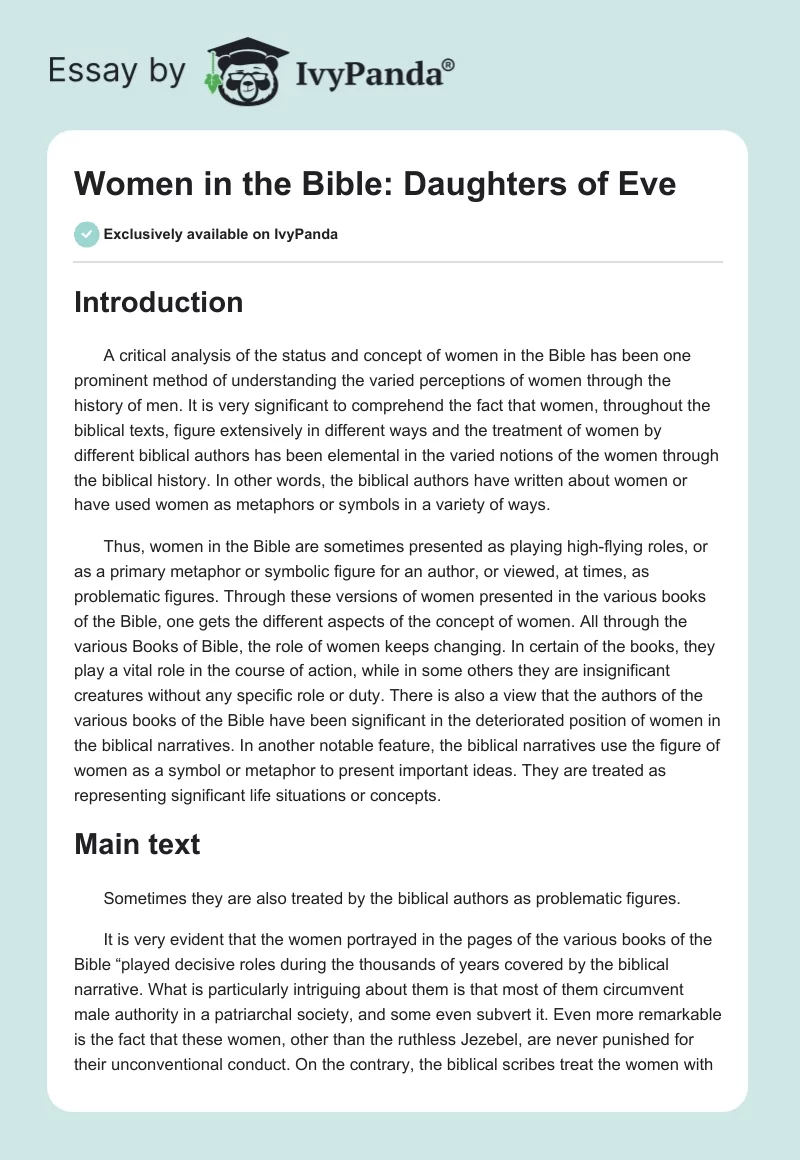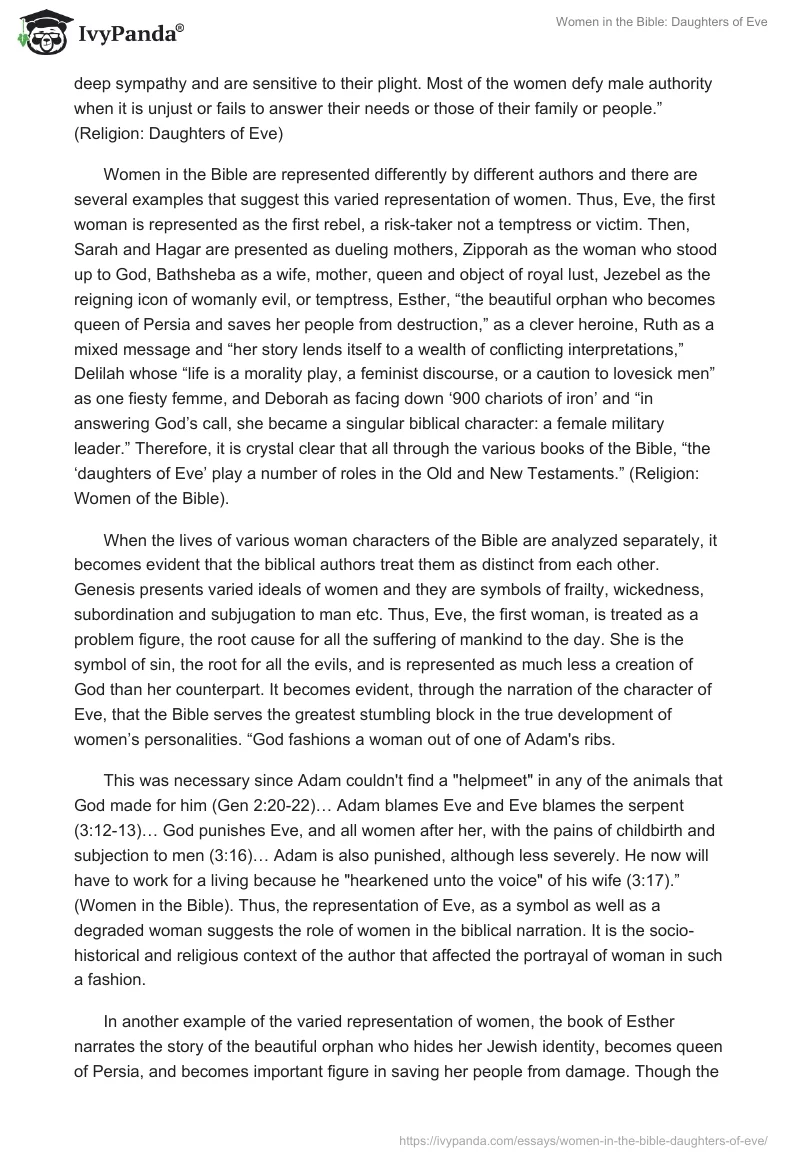Introduction
A critical analysis of the status and concept of women in the Bible has been one prominent method of understanding the varied perceptions of women through the history of men. It is very significant to comprehend the fact that women, throughout the biblical texts, figure extensively in different ways and the treatment of women by different biblical authors has been elemental in the varied notions of the women through the biblical history. In other words, the biblical authors have written about women or have used women as metaphors or symbols in a variety of ways.
Thus, women in the Bible are sometimes presented as playing high-flying roles, or as a primary metaphor or symbolic figure for an author, or viewed, at times, as problematic figures. Through these versions of women presented in the various books of the Bible, one gets the different aspects of the concept of women. All through the various Books of Bible, the role of women keeps changing. In certain of the books, they play a vital role in the course of action, while in some others they are insignificant creatures without any specific role or duty. There is also a view that the authors of the various books of the Bible have been significant in the deteriorated position of women in the biblical narratives. In another notable feature, the biblical narratives use the figure of women as a symbol or metaphor to present important ideas. They are treated as representing significant life situations or concepts.
Main text
Sometimes they are also treated by the biblical authors as problematic figures.
It is very evident that the women portrayed in the pages of the various books of the Bible “played decisive roles during the thousands of years covered by the biblical narrative. What is particularly intriguing about them is that most of them circumvent male authority in a patriarchal society, and some even subvert it. Even more remarkable is the fact that these women, other than the ruthless Jezebel, are never punished for their unconventional conduct. On the contrary, the biblical scribes treat the women with deep sympathy and are sensitive to their plight. Most of the women defy male authority when it is unjust or fails to answer their needs or those of their family or people.” (Religion: Daughters of Eve)
Women in the Bible are represented differently by different authors and there are several examples that suggest this varied representation of women. Thus, Eve, the first woman is represented as the first rebel, a risk-taker not a temptress or victim. Then, Sarah and Hagar are presented as dueling mothers, Zipporah as the woman who stood up to God, Bathsheba as a wife, mother, queen and object of royal lust, Jezebel as the reigning icon of womanly evil, or temptress, Esther, “the beautiful orphan who becomes queen of Persia and saves her people from destruction,” as a clever heroine, Ruth as a mixed message and “her story lends itself to a wealth of conflicting interpretations,” Delilah whose “life is a morality play, a feminist discourse, or a caution to lovesick men” as one fiesty femme, and Deborah as facing down ‘900 chariots of iron’ and “in answering God’s call, she became a singular biblical character: a female military leader.” Therefore, it is crystal clear that all through the various books of the Bible, “the ‘daughters of Eve’ play a number of roles in the Old and New Testaments.” (Religion: Women of the Bible).
When the lives of various woman characters of the Bible are analyzed separately, it becomes evident that the biblical authors treat them as distinct from each other. Genesis presents varied ideals of women and they are symbols of frailty, wickedness, subordination and subjugation to man etc. Thus, Eve, the first woman, is treated as a problem figure, the root cause for all the suffering of mankind to the day. She is the symbol of sin, the root for all the evils, and is represented as much less a creation of God than her counterpart. It becomes evident, through the narration of the character of Eve, that the Bible serves the greatest stumbling block in the true development of women’s personalities. “God fashions a woman out of one of Adam’s ribs.
This was necessary since Adam couldn’t find a “helpmeet” in any of the animals that God made for him (Gen 2:20-22)… Adam blames Eve and Eve blames the serpent (3:12-13)… God punishes Eve, and all women after her, with the pains of childbirth and subjection to men (3:16)… Adam is also punished, although less severely. He now will have to work for a living because he “hearkened unto the voice” of his wife (3:17).” (Women in the Bible). Thus, the representation of Eve, as a symbol as well as a degraded woman suggests the role of women in the biblical narration. It is the socio-historical and religious context of the author that affected the portrayal of woman in such a fashion.
In another example of the varied representation of women, the book of Esther narrates the story of the beautiful orphan who hides her Jewish identity, becomes queen of Persia, and becomes important figure in saving her people from damage. Though the book is meaningful in diverse ways, “the real meaning of Esther’s story, some biblical scholars say, is a lesson about hope and how to deal with assimilation. In Esther, Jews can find a model of strength and determination: one who shows how even in persecution, they can survive and prosper. “Esther provides hope for the Jewish people, in good times and bad. They hope for someone like Esther to deliver them,” says Carey Moore.” (Brophy). Thus, the woman in this book is represented as a prominent figure, a metaphor for courage and redemption.
Summary
The representation of women by different biblical authors varies and the books of Ketuvim also illustrate the varied status and representation of the concept of women. Therefore, in a significant conclusion of the narration of women through the different biblical narratives, it is clear that women become symbols and metaphors of the author’s intention.
Works Cited
Religion: Daughters of Eve. US News and World Report. 2008. Web.
Religion: Women of the Bible. US News and World Report. 2008. Web.
Brophy, Beth. Religion: Esther has Shown Jews How to Survive Persecution: A Clever Heroine. US News and World Report. 2008. Web.
Women in the Bible. the Skeptic’s Annotated Bible. 2008. Web.


